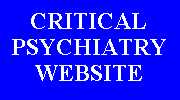
Review of Alternatives beyond psychiatry
Psychiatry does not always provide what people want. Worse than this, its treatments can be abusive and damaging, as though it is compulsively drawn to repeat the abuse and damage that have brought many patients to psychiatry in the first place. For example, the first chapter in this book is written by Dorothea Buck-Zerchin, who was sterilised without consent in 1936 at a Hospital for Nervous and Mood Diseases in Germany. She described the treatment she received there, which included "buckets of cold water poured over our heads, with lengthy baths in a tub covered with a canvas that bore a stiff high collar in which my neck was fixed for 23 hours, … wet packs and sedating injections of paraldehyde. A wet pack meant to be bound into cold, wet sheets so tightly that one could no longer move at all. From our body temperature, the sheets would become first warm and then hot. I would cry out in rage at this senseless restraint in these hot sheets."
Buck-Zerchin does not describe her state of mind at the time. Presumably her treatment was intended to help control her disturbance. The "sharp end" of psychiatry still includes control and restraint, seclusion and forced injections. Maybe it is better to see these interventions as a failure of treatment, rather than as treatment itself.
Some would go further than this and say we should run society without specific mental health legislation. For example, as far as Thomas Szasz is concerned, coercion should only be used in the criminal system if someone has broken the law. Nonetheless there are issues of mental capacity when people are psychotic. Furthermore, some reforms of mental health legislation, such as the UK Mental Health Act 1983, have been motivated by attempts to improve the rights of psychiatric patients.
Buck-Zerchin also complains that "nobody actually spoke with us". People may be devalued by psychiatry, not least because of the biologically reductionistic way in which mental illness may be perceived. There were also particular issues for German psychiatry at the time with the Nazis implementing the idea of mercy killing of those with "unworthy lives", including the mentally ill. Buck-Zerchin mentions Professor Gottfried Ewald, who was the only psychiatrist who openly opposed the medical-killing project. He practised as a psychiatrist within a discipline that essentially complied with the Nazi regime. Although of a different order, courage and integrity is still required to stand out against the biological reductionism of modern psychiatry.
The two editors are a psychiatrist in New York City and a survivor of psychiatry living in Berlin. They have brought together a miscellaneous collection of essays that contain descriptions of people’s experience under psychiatry and what they have done to avoid coming under its clutches, with examples of organised self-help and better models of professional support from several countries, including for specific groups such as ethnic minorities. The representation of service users’ rights, user involvement in research and services, campaign networks and the need for change of the psychiatric system are also described. There is little attempt to provide a general systematic theory of an alternative approach. The alternative movement in the book combines a wide range of critical approaches, including what are seen as non-, anti- and post-psychiatry.
Maybe it is a weakness of the book not to have a clearer theoretical paradigm. Perhaps only a strong ethical, psychosocial understanding can counter the excesses of psychiatry experienced by Dorothea Buck-Zerchin. It is all very well to have a sense of outrage afterwards, but what would make a change? I guess the choice of the preposition ‘beyond’ in relation to psychiatry is supposed to mean a place and time which psychiatry has not yet reached, when the alternatives described in the book will be in place. Are the book’s editors indulging in wishful thinking? Possibly they should have been clearer about what they mean by alternatives. For example, the Soteria treatment model introduced by Loren Mosher is praised. Should this model be integrated with other community mental health services, as in Soteria Berne, or be kept separate from the mainstream?
I am not meaning to haggle about these relatively trivial points. The scope of the book overall should be welcomed. It ends with a plea to become involved in advocating for humane treatment in psychiatry. We all need to be reminded of this minimal requirement. It is where professionals and service users should come together.